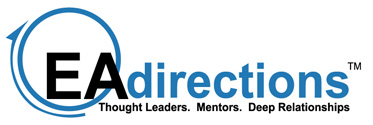Now that everyone is back from the holidays, relaxed and enthusiastic, it is a good time to take a look forward and update your EA program’s objectives for the new year. In our experience, most organizations have a very short window to accomplish this. It doesn’t take long before the enthusiasm and vision for the future is replaced by the urgency and narrowness of the day. Since creating a coherent future target-state view is the core idea that drives what the EA program does for the organization, it makes sense to use this moment of clarity to apply that same concept directly to the EA program itself. Doing so should drive the evolution of your EA program throughout this year and into the next.
Begin by answering a few simple (OK, not so simple) questions: What would you like your EA program to look like a year from now? Two or three years? How would you like it to work? Who needs to be engaged? How are we going to create value to our organizations? Those are your goals, driven by your vision. These are just a few of the many questions to be answered before jumping in and creating detailed work plans. It has to drive you to achieve your idea of what a smoothly running program should be and to the level of value delivery you want for your organization.
Only then can you lay out the granular steps along the path to get there. Those become the objectives. This exercise doesn’t have to be hard. It doesn’t have to be an exhaustive and thorough definition of tasks and highly detailed sub-tasks, with explicit milestones and work allocation down to the hour. Watch out to not fall into that trap. Many organizations expect it, but a project plan with that level of detail often becomes a burden that inhibits EA evolution instead of enabling it. There are many reasons why EA isn’t well-suited to that level of detailed planning, many of which are unique to a particular organization. Call us if you are interested in exploring those reasons and why they may apply to your organization. In all cases, though, the continuous improvement of an EA program does require a thoughtful and meaningful planning activity. What’s really important is to build a plan to a level of detail that supports your long term objectives balanced with more immediate value opportunities.
Here are a few examples of what our clients are planning for the year:
- Expand the reach of the EA program within the organization. Using a variety of tactics that include active recruiting, more effective personal networking, public relations activities, etc. it is important that a larger community of individuals contribute content and ideas and then, indirectly, begin to see the value in the work that the EA group performs. An important note – “teaching” people about EA is less important than involving them in EA activities.
- Enhance governance bodies and processes to include a higher-level, cross-organizational perspective. Too often, EA is buried too deeply into narrow, infrastructure concerns within IT. Will business people care about things like network/integration topography choices and standards taxonomies? Probably not, so you have to work in areas that they really will care.
- Expand the scope of EA. With some recent nudging, the best EA groups have pushed into the business domains, to take into account the full holistic breadth of enterprise concerns, particularly business, information architectures and application portfolios.
- Balance the workload between strategic, future state development and align with current state priorities. Our clients are either facing major initiatives (ERP implementations, major business process transformation) or economic pressure causing significant budget and resource constraints or both. They need to balance strategy work with contributions to efforts with immediate results.
Objective setting isn’t easy. You have to pick the “right” objectives. Then you have to determine the right order, and to what degree, to apply them. An “EA Capabilities Assessment” is a helpful place to start. Unlike an “EA Maturity Assessment”, if is actionable and can directly reveal your strengths and what weaknesses you must overcome. Doing full-year objective setting well requires a combination of insight into organizational dynamics, understanding what your resources are capable of, and how much change your organization can tolerate. This is one place where our experience can help. As you think about the coming year, contact us. We’ll be happy to discuss approaches that make sense for you and your organization and give you more insight into what is achievable.
